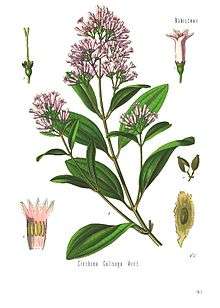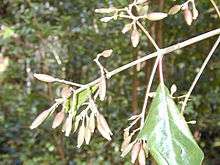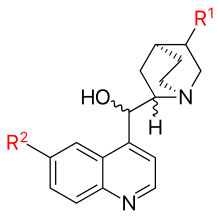Cinchona
| Cinchona | |
|---|---|
 | |
| Cinchona pubescens - flowers | |
| Scientific classification | |
| Kingdom: | Plantae |
| (unranked): | Angiosperms |
| (unranked): | Eudicots |
| (unranked): | Asterids |
| Order: | Gentianales |
| Family: | Rubiaceae |
| Subfamily: | Cinchonoideae |
| Tribe: | Cinchoneae[1] |
| Genus: | Cinchona L. |
| Type species | |
| Cinchona officinalis L. | |
| Species | |
|
about 38 species; see text | |
Cinchona (/sɪŋˈkoʊnə/ or /-kəʊnə/)[2] is a genus of flowering plants in the family Rubiaceae containing at least 23 species of trees and shrubs.[3] They are native to the tropical Andean forests of western South America.[4] A few species are reportedly naturalized in Central America, Jamaica, French Polynesia, Sulawesi, Saint Helena in the South Atlantic, and São Tome & Principe off the coast of tropical Africa. A few species are used as medicinal plants, known as sources for quinine and other compounds.
Linnaeus named the genus in 1742 after Ana de Osorio, the 4th Countess of Chinchón and wife of a viceroy of Peru. According to some accounts, she suffered from malaria and was cured by a botanical remedy made of the powdered bark of a native tree. The veracity of the story is uncertain, but the tree still carries her name.[4][5]
The National Tree of Peru is in the genus Cinchona.[6]
Description
Cinchona plants are large shrubs or small trees with evergreen foliage, growing 5–15 m (16–49 ft) in height. The leaves are opposite, rounded to lanceolate and 10–40 cm long.
The flowers are white, pink or red, produced in terminal panicles. The fruit is a small capsule containing numerous seeds.
History
The medicinal properties of the cinchona tree were originally discovered by the Quechua peoples of Peru, Bolivia, and Ecuador, and long cultivated by them as a muscle relaxant to abate shivering due to low body temperatures, and symptoms of malaria. Ana de Osorio, wife of the count of Chinchón then serving as viceroy of Peru, contracted malaria and native people persuaded her to bathe in a small pond beneath a tree whose quinine made its waters bitter. After a few days, she was cured. Linnaeus later named the tree in her honor. Later the Jesuit brother Agostino Salumbrino (1561–1642), an trained apothecary who lived in Loja in Ecuador and Lima in Peru, observed the Quechua using the quinine-containing bark of the cinchona tree to cure malaria. While its effect in treating malaria and malaria-induced shivering was entirely unrelated to the plant's efficacy in controlling shivering from cold, it was nevertheless the correct medicine for malaria. The use of the “fever tree” bark was introduced into European medicine by Jesuit missionaries. Jesuit Bernabé Cobo (1582–1657), who explored Mexico and Peru, is credited with taking cinchona bark to Europe. He took the bark from Lima to Spain, and afterwards to Rome and other parts of Italy, in 1632. To maintain their monopoly on cinchona bark, Peru and surrounding countries began outlawing the export of cinchona seeds and saplings beginning in the early 19th century.
In the 19th century, the plant's seeds and cuttings were smuggled out for new cultivation at cinchona plantations in colonial regions of tropical Asia, notably by the British to the British Raj and Ceylon (present-day India and Sri Lanka), and by the Dutch to Java in the Dutch East Indies (present-day Indonesia).[7]
As a medicinal herb, cinchona bark is also known as Jesuit's bark or Peruvian bark. The bark is stripped from the tree, dried, and powdered for medicinal uses. The bark is medicinally active, containing a variety of alkaloids including the antimalarial compound quinine and the antiarrhythmic quinidine. Although the use of the bark has been largely superseded by more effective modern medicines, cinchona is the only economically practical source of quinine, a drug that is still recommended for the treatment of Malaria.[8]
Ecology
Cinchona species are used as food plants by the larvae of some Lepidoptera species, including the engrailed, the commander, and members of the genus Endoclita, including E. damor, E. purpurescens and E. sericeus.
Medicinal uses
.jpg)

- South America
The cinchona tree's medicinal uses were first discovered by the Quechua people of Peru and Bolivia.[lower-alpha 1]
- Europe
The Italian botanist Pietro Castelli wrote a pamphlet noteworthy as being the first Italian publication to mention the cinchona. By the 1630s (or 1640s, depending on the reference), the bark was being exported to Europe. In the late 1640s, the method of use of the bark was noted in the Schedula Romana, and in 1677, the use of the bark was noted in the London Pharmacopoeia.
English King Charles II called upon Robert Talbor, who had become famous for his miraculous malaria cure.[9] Because at that time the bark was in religious controversy, Talbor gave the king the bitter bark decoction in great secrecy. The treatment gave the king complete relief from the malaria fever. In return, Talbor was offered membership of the prestigious Royal College of Physicians.
In 1679, Talbor was called by the King of France, Louis XIV, whose son was suffering from malaria fever. After a successful treatment, Talbor was rewarded by the king with 3,000 gold crowns and a lifetime pension for this prescription. Talbor was asked to keep the entire episode secret.
After Talbor's death, the French king found this formula: seven grams of rose leaves, two ounces of lemon juice and a strong decoction of the cinchona bark served with wine. Wine was used because some alkaloids of the cinchona bark are not soluble in water, but are soluble in the ethanol in wine.
In 1738, Sur l'arbre du quinquina, a paper written by Charles Marie de La Condamine,lead member of the expedition, along with Pierre Godin and Louis Bouger that was sent to Ecuador to determine the length of a degree of the 1/4 of meridian arc in the neighbourhood of the equator, was published by the French Academy of Sciences. In it he identified three separate species.[10]
In 1743, on the basis of a specimen received from La Condamine, Linnaeus named the tree Chinchona citing La Condamine's paper. Establishing his binomial system In 1753, he further designated it as Cinchona officinalis[11][12]
- Homeopathy
The birth of homeopathy was based on cinchona bark testing. The founder of homeopathy, Samuel Hahnemann, when translating William Cullen's Materia medica, noticed Cullen had written that Peruvian bark was known to cure intermittent fevers.[13] Hahnemann took daily a large, rather than homeopathic, dose of Peruvian bark. After two weeks, he said he felt malaria-like symptoms. This idea of "like cures like" was the starting point of his writings on homeopathy. Hahnemann's symptoms are believed to be the result of a hypersensitivity to cinchona bark on his part.[14]
Cultivation
The bark was very valuable to Europeans in expanding their access to and exploitation of resources in distant colonies and at home. Bark gathering was often environmentally destructive, destroying huge expanses of trees for their bark, with difficult conditions for low wages that did not allow the indigenous bark gatherers to settle debts even upon death.[15]
Further exploration of the Amazon Basin and the economy of trade in various species of the bark in the 18th century is captured by the extract from a book by Lardner Gibbon:
"...this bark was first gathered in quantities in 1849, though known for many years. The best quality is not quite equal to that of Yungas, but only second to it. There are four other classes of inferior bark, for some of which the bank pays fifteen dollars per quintal. The best, by law, is worth fifty-four dollars. The freight to Arica is seventeen dollars the mule load of three quintals. Six thousand quintals of bark have already been gathered from Yuracares. The bank was established in the year 1851. Mr. [Thaddäus] Haenke mentioned the existence of cinchona bark on his visit to Yuracares in 1796". (Source: Exploration of the Valley of the Amazon, by Lieut. Lardner Gibbon, USN. Vol.II, Ch.6, pp. 146-47.)
- Asia
In 1860, a British expedition to South America led by Clements Markham brought back smuggled cinchona seeds and plants, which were introduced in several areas of the British Raj in India and Sri Lanka. In India, it was planted in Ootacamund by William Graham McIvor. In Sri Lanka, it was planted in the Hakgala Botanical Garden in January 1861.[16] James Taylor, the pioneer of tea planting in Sri Lanka, was one of the pioneers of cinchona cultivation.[17] By 1883, about 64,000 acres (260 km2) were in cultivation in Sri Lanka, with exports reaching a peak of 15 million pounds in 1886. It was also cultivated by British in 1862 in the hilly terrain of Darjeeling District of West Bengal, India. There is a factory and plantation named after Cinchona at Mungpoo, Darjeeling, West Bengal. The factory is called a Govt. Quinine Factory. Cultivation of Cinchona continues at places like Mungpoo, Munsong, Latpanchar, and Rongo under the supervision of the government of West Bengal's Directorate of Cinchona & Other Medicinal Plants.
- Mexico
In 1865, "New Virginia" and "Carlota Colony" were established in Mexico by Matthew Fontaine Maury, a former confederate in the American Civil War. Postwar confederates were enticed there by Maury, now the "Imperial Commissioner of Immigration" for Emperor Maximillian of Mexico, and Archduke of Habsburg. All that survives of those two colonies are the flourishing groves of cinchonas established by Maury using seeds purchased from England. These seeds were the first to be introduced into Mexico.[18]

Chemistry
Cinchona alkaloids

The bark of trees in this genus is the source of a variety of alkaloids, the most familiar of which is quinine, an antipyretic (antifever) agent especially useful in treating malaria.
Cinchona alkaloids include:
- cinchonine and cinchonidine (stereoisomers with R1 = vinyl, R2 = hydrogen)
- quinine and quinidine (stereoisomers with R1 = vinyl, R2 = methoxy)
- dihydroquinine and dihydroquinidine (stereoisomers with R1 = ethyl, R2 = methoxy)
They find use in organic chemistry as organocatalysts in asymmetric synthesis.
Other chemicals
Alongside the alkaloids, many cinchona barks contain cinchotannic acid, a particular tannin, which by oxidation rapidly yields a dark-coloured phlobaphene[19] called red cinchonic,[20] cinchono-fulvic acid or cinchona red.[21]
Species
There are at least 23 species recognized by botanists. There are likely several unnamed species and many intermediate forms that have arisen due to the plants' tendency to hybridize.[3] Resolution of species boundaries is awaiting results of DNA studies. Several species formerly in the genus are now placed in Cascarilla.
Medicinal species
- Cinchona calisaya Wedd. (1848)[lower-alpha 2]
- Cinchona officinalis L. (1753) - quinine bark
- Cinchona pubescens Vahl (1790) - quinine tree
Other species
|
See also
Notes
- ↑ According to legend, the first European ever to be cured from malaria fever was Ana de Osorio, 4th countess of Chinchón, the wife of the Spanish Luis Jerónimo de Cabrera who served as viceroy of Peru. The namesake Chinchón is a small town in central Spain. In the Viceroyalty of Peru, the court physician was summoned and urged to save the countess from the waves of fever and chill threatening her life, but every effort failed to relieve her. At last, the physician administered some medicine he had obtained from the local Indians, who had been using it for similar syndromes. The countess survived the malarial attack and reportedly brought the cinchona bark back with her when she returned to Europe in the 1640s.
- ↑ The variety of Calisayan cinchona introduced to the Dutch East Indies was also sometimes distinguished as Cinchona pahudiana,[22] named in honor of the Dutch colonial minister C.F. Pahud.
References
Citations
- ↑ "Genus Cinchona". Taxonomy. UniProt. Retrieved 2010-02-13.
- ↑ "cinchona, n.", Oxford English Dictionary.
- 1 2 Cinchona. Selected Rubiaceae Tribes and Genera. Tropicos. Missouri Botanical Garden.
- 1 2 Motley, Cheryl. "Cinchona and its product--Quinine". Ethnobotanical leaflets. Southern Illinois University Herbarium. Retrieved 11 June 2010.
- ↑ Meyer, Christian G.; Marks, Florian; May, Jürgen (2004-12-01). "Editorial: Gin tonic revisited". Tropical Medicine & International Health. 9 (12): 1239–1240. doi:10.1111/j.1365-3156.2004.01357.x. ISSN 1365-3156.
- ↑ Deborah Kopka (12 Jan 2011). Central & South America. Milliken Pub. Co. p. 130. ISBN 978-1429122511. Retrieved 15 April 2013.
- ↑ Rice, Benjamin Lewis (1897). Mysore: A Gazetteer Compiled for Government Vol. 1. Westminster: A Constable. p. 892.
- ↑ Guidelines for the treatment of malaria. Second edition March 2010, World Health Organization, 2010. Available on-line at: WHO Document centre
- ↑ See:
- Paul Reiter (2000) "From Shakespeare to Defoe: Malaria in England in the Little Ice Age," Emerging Infectious Diseases, 6 (1) : 1-11. Available on-line at: National Center for Biotechnology Information.
- Robert Talbor (1672) Pyretologia: a Rational Account of the Cause and Cures of Agues.
- Robert Talbor (1682) The English Remedy: Talbor’s Wonderful Secret for Curing of Agues and Feavers.
- ↑ Joseph P. Remington, Horatio C. Wood, ed. (1918). "Cinchona". The Dispensatory of the United States of America.
- ↑ Linné, Carolus von. Genera Plantarum 2nd edition 1743. page 413
- ↑ Linné, Carolus von. Species Plantarum. 1st edition. 1752. volume 1. page 172.
- ↑ William Cullen, Benjamin Smith Barton (1812). Professor Cullen's treatise of the materia medica. Edward Parker.
- ↑ William E. Thomas. "Chapter 2: The basis of Homeopathy". Homeopathy; Historical Origins and the End.
- ↑ Taussig, M. (1987). Shamanism, Colonialism and the Wild Man. University of Chicago Press.
- ↑ "Hakgala garden". Department of Agriculture, Government of Sri Lanka. Retrieved 11 June 2010.
- ↑ Fry, Carolyn (6 January 2007). "The Kew Gardens of Sri Lanka". Travel. London: Timesonline, UK. Retrieved 11 June 2010.
- ↑ Sources: "Life of Maury" by Diane Corbin and "Scientist of the Sea" by Frances Leigh Williams.
- ↑ Henry G. Greenish (1920). "Cinchona Bark (Cortex Cinchonae). Part 3". A Text Book Of Materia Medica, Being An Account Of The More Important Crude Drugs Of Vegetable And Animal Origin. J. & A. Churchill. ASIN B000J31E44.
- ↑ Alfred Baring Garrod (2007). "Cinchonaceae. Part 2". Essentials Of Materia Medica And Therapeutics. Kessinger Publishing. ISBN 1-4326-8837-5.
- ↑ "Quinine". Encyclopaedia Britannica (10 ed.). 1902.
- ↑ EB (1878), p. 781.
Bibliography
- "Cinchona Bark", Encyclopedia Americana, Vol. VI, New York, 1920.
- "Cinchona", Encyclopædia Britannica, 9th ed., Vol. V, New York: Charles Scribner's Sons, 1878, pp. 780–2.
- "Cinchona", Encyclopædia Britannica, 11th ed., Vol. VI, Cambridge: Cambridge University Press, 1911, pp. 369–70.
- Druilhe, P.; et al., "Activity of a Combination of Three Cinchona Bark Alkaloids against Plasmodium falciparum in vitro", Antimicrobial Agents and Chemotherapy, Vol. 32 (No. 2), pp. 250–4, doi:10.1128/aac.32.2.250.
- Schultes, Richard Evans; et al., eds. (1998), The Journals of Hipólito Ruiz: Spanish Botanist in Peru and Chile 1777–1788, Timber Press.
External links
| Wikimedia Commons has media related to Cinchona. |
| Wikimedia Commons has media related to |
- Burba, J. Cinchona Bark. University of Minnesota Libraries.
- Using Bark to Cure the Bite. Botany Global Issues Map. McGraw Hill.
- Peruvian Bark, Cinchona succirubra. Botanical.com
- Cinchona Project Field Books, 1938-1965 from the Smithsonian Institution Archives